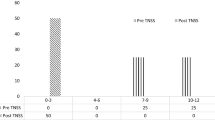Abstract
Nasal allergy is characterized by an IgE mediated inflammatory response of nasal mucosa to allergens and it has a close association with Asthma. Nasal allergy has been demonstrated to be a strong risk factor for the onset of asthma in adults. Spirometric parameters like Forced expiratory volume at timed interval of 1 s (FEV1) and forced expiratory flow (FEF25–75 %) are impaired in patients with nasal allergy or allergic rhinitis. The FEF25–75 % has been evidenced to be a reliable marker of early bronchial impairment in nasal allergy. Nasal allergy may be considered as the first step of the progression of respiratory allergy towards asthma. It has been demonstrated that FEF25–75 % is useful in predicting the presence of airway hyper responsiveness.It may be a more sensitive indicator of chronic airway obstruction than FEV1 and is considered as a risk factor for the persistence of respiratory symptoms in asthmatic patients. The impact of allergic rhinitis or nasal allergy on asthma (ARIA) guidelines, clearly underlined the role of allergic rhinitis as risk factor for asthma development. The possible presence of spirometric abnormalities in patient with allergic rhinitis has been well documented. So keeping this in mind, present study is undertaken to evaluate the impairment of spirometric parameters, like FEV1, FEF25–75 %, and forced vital capacity, in patients with nasal allergy and to predict the presence of airway hyper responsiveness.
Similar content being viewed by others
References
Beasly R (1997) ISAAC-Phase I results: global comparison (Abstract). Eur Resp J 17:s212
Beers MH, Berkow R (1999) The Merck manual of diagnosis and therapy, 17th edn. Merck Research Laboratories, Whitehouse Station
Bjermer L (2001) Past and future perspectives in the asthma treatment. Resp Med 95:703–719
Bousquet J, Knani J, Henry C et al (1996) Undertreatment in a nonselected population of adult patients with asthma. J Allergy Clin Immunol 98:514–521
Bousquet J, Van Cauwenberge P, Khaltaev N (2001) Allergic rhinitisand its impact on asthma. J Allergy Clin Immunol 108(5 Suppl):S147–S334
Ciprandi G, Cirillo I, Tosca MA, Vizzaccaro A (2004) Bronchial hyperreactivity and spirometric impairment in patients with perennial allergic rhinitis. Int Arch Allergy Immunol 133:14–18
Ciprandi G, Cirillo I, Klersy C, Marseglia GL, Vizzaccaro A, Pallestrini E et al (2006) Role of FEF25–75 as an early marker of bronchial impairment in patients with seasonal allergic rhinitis. Am J Rhinol 20(6):641–647
Ciprandi G, Cirillo I, Pistorio A (2008) Impact of allergic rhinitis on asthma: effects on spirometric Parameters. Allergy 63:255–260
Corren J (2007) The connection between allergic rhinitis and bronchial asthma. Curr Opin Pulm Med 13(1):13–18
D’Amato G, Cecchi L (2008) Effects of climate change on environmental factors in respiratory allergic diseases. Clin Exp Allergy 38(8):1264–1274
Davila I, Mullol J et al (2009) Genetic aspects of allergic rhinitis. J Investig Allergol Clin Immunol 19(Suppl 1):25–31
Demoly P, Gauchoux R, Morera P, Touron D, Daures JP (2005) The place of spirometry in the diagnosis of asthma in those suffering from allergic rhinitis: a pilot study. Allergy 60:1089–1090
Domnic V et al, (2006) Hyper responsiveness of trachio bronchial tree in previously allergic rhinitis patients, 72(8), Lippincott Williams and Wilkins, Philadelphia, pp 64–68
Fokkens W, van Drunen CM (2006) Nose and lung, two of a kind? Allergy 61:653–655
Haarter TV, Peebles RS (2000) Epidemiology of asthma: the year in review. Curr Opin Pulm Med 6:4–9
Hamid Q, Song Y, Kotsimbos TC et al (1997) Inflammation of small airways in asthma. J Allergy Clin Immunol 100:44–51
Katelaris CH (2003) Allergic rhinitis and asthma: epidemiological evidence for the link. Clin Exp Allergy Rev 3:5–8
Lim MY, Leong JL (2010) Allergic rhinitis: evidence-based practice. Singapore Med J 51(7):542–550
Lipworth BJ, Clark DJ (1997) Effects of airway calibre on lung delivery of nebulised salbutamol. Thorax 52:1016–1023
Lowell FC (1967) Clinical aspects of eosinophilia in atopic disease. JAMA 202:875–878
MacMillan D (1973) Assessment of cases of perennial rhinitis. J Laryngol Otol 87:991–996
Pederson PA, Weeke ER (1983) Asthma and allergic rhinitis in the same patients. Allergy 38:25–29
Plaschke PP, Janson C, Norrman E, Bjornsson E, Ellbjar S, Jarrholm B (2000) Onset and remission of allergic rhinitis and asthma and the relationship with atopic sensitization and smoking. Am J Respir Crit Care Med 162:920–924
Prieto L et al (1998) Variability of peak expiratory flow rate in allergic rhinitis. Annl Allergy Asthma Immunol 80(2):151–158
Sengupta RP, Das S, Roy A (1975) Study in nasal allergy. Ind J Otol 27:67
Settipane GA (1986) Allergic rhinitis—update. Otolaryngol Head Neck Surg 94:470–475
Sheldon JM, Lovele RG, Mathews KP (1953) A manual of clinical allergy. W.B. Sounder Co., Philadelphia
Wallace DV, Dykewicz MS et al (2008) The diagnosis and management of rhinitis: Anupdated practice parameter. J Allergy Clin Immunology 122(2):S1–S84
William TK, Bryan MP (1976) Bryan Allergy in otolaryngology
Woodward FD, Swineford O (1941) Allergic rhinitis. Arch Otol 34:1123
Author information
Authors and Affiliations
Corresponding author
Ethics declarations
Conflict of interest
The authors declare that they have no conflict of interest.
Rights and permissions
About this article
Cite this article
Poorey, V.K., Soni, S., Thakur, P. et al. Effect of Nasal Allergy Over Spirometric Parameters: A Prospective Study. Indian J Otolaryngol Head Neck Surg 68, 6–10 (2016). https://doi.org/10.1007/s12070-015-0876-x
Received:
Accepted:
Published:
Issue Date:
DOI: https://doi.org/10.1007/s12070-015-0876-x




